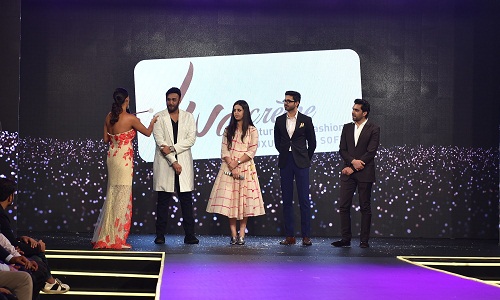FW
"Dollar Industries celebrated their first listing day on National Stock Exchange last Friday. The event saw the ringing of listing bell at 10:00 am at National Stock Exchange, BKC, Mumbai. The event started with the lighting of traditional lamp in the presence of Dindayal Gupta, Chairman, Dollar; Vinod Gupta, MD, Binay Kumar Gupta, Joint MD; Gaurav Jain, MD, Hem Securities, Advisor to the listing; Ishita Vora, Head Primary Markets, National Stock Exchange; Shashi Agarwal, CFO, Dollar Industries; and Rakesh Biyani, an independent Director with Dollar."
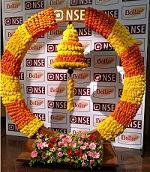
Dollar Industries celebrated their first listing day on National Stock Exchange last Friday. The event saw the ringing of listing bell at 10:00 am at National Stock Exchange, BKC, Mumbai. The event started with the lighting of traditional lamp in the presence of Dindayal Gupta, Chairman, Dollar; Vinod Gupta, MD, Binay Kumar Gupta, Joint MD; Gaurav Jain, MD, Hem Securities, Advisor to the listing; Ishita Vora, Head Primary Markets, National Stock Exchange; Shashi Agarwal, CFO, Dollar Industries; and Rakesh Biyani, an independent Director with Dollar.
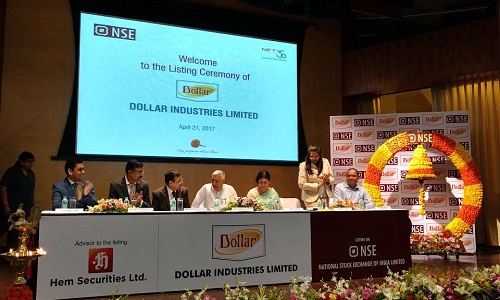
Dollar’s journey began in 1972. The proprietary firm Dollar Textiles it became Dollar Textiles Limited in 2005 and Dollar Industries Limited in 2008. Their signature brand is Dollar. Dollar Club had a range of vests and briefs. “We converted that into Dollar Big Boss, which became a sensation in the market. The brand ambassador is Akshay Kumar. It’s been six years with him and our association with Kumar is getting stronger and stronger,” remarks Vinod Gupta, MD, Dollar Industries. “We were the first hosiery company to have micro modal fiber in innerwear. Our overall range has vests, briefs, trunks in the latest cuts and fits. In apparel, we have basic and fashion denim, T-shirts, casual wear like Bermudas and track pants. In winter wear, we have premium thermals for men, women and children.” Dollar has a children’s brand called ‘Champion’ and their women’s wear brand is call Missy also in their basket is casual wear brand called ‘Force’.
Vinod Gupta explains they are the first inner wear company in India to have a fully backward integrated manufacturing unit which is located in Jaipur. Then they have a state of the art processing unit equipped with latest processing technology to produce finished raw material in any possible color. The production capacity is 13.5 tons a day and there is a spinning unit. At Dollar R&D plays a major role to ensure products combine fashion and functionality.
An inspirational journey
Vinod Gupta says while Dollar is playing the value game through progressive premiumisation, they are catering to the economy segment as well through various initiatives. The economy segment accounted for 45 per cent revenues in 2015-16, translating to Rs 360 crores compared to Rs 356 crores in the preceding year.
Talking about their journey Shashi Agarwal, CFO, Dollar Industries says, “It has been a great journey for us in the last 45 years. With constant product diversification, we have grown on an average at 13 per cent for the last five years. Last year revenues grew 30.5 per cent. We have 800 distributors and agents across India. They have helped us go deep into the country. We have a presence across 26 states and are in 80,000 MBOs in 800 cities. Our four manufacturing units are in Tirupur, Kolkata, Delhi, Ludhiana. Innovations are a way of life for Dollar. We will continue with the quest for increasing our market value. We will expand our portfolio and enter new markets and provide customer satisfaction.”
Upcoming Initiatives
The company is looking to strengthen its aspirational positioning in 2015-16. For years, there were two main segments– economy and premium. During the last fiscal year, the company took the initiative and launched ‘Force NXT’ aimed at the super-premium category. Gupta says, “This extension represents an idea whose time has come. There has been a major rethink on selection of innerwear for super-premium since these products are made of superior yarn fabric and stitched with superior thread. Dollar began to address this segment from the second half of the last fiscal, the benefits will start becoming evident from the current financial year.
Optimism about the future perfect
Talking about future growth prospects, Gupta says, “We are optimistic about generating Rs 1000 crores in revenues in 2016-17 despite economic slowdown and consumer downtrading. The ability to pass on an increase in raw cotton prices should make the achievement of our goal easier in addition to our being able to generate a higher throughput per dealer, address market gaps effectively and increase off take from our premium and super premium categories. In doing so, we believe we would be the fastest in our sector to get to this four-digit benchmark.”
The company keeps tab on latest trends to add value to the Dollar experience. It’s the largest selling Indian inner wear brand in the UAE and Middle East. Dollar owns 15 per cent market share in India, catering to the middle and upper segments. “We want Dollar to be a part of everyone’s life in India and abroad. We want to be a multinational providing trend setting solutions,” sums up Gupta.
For Lenzing sustainability is an integral feature of group strategy. Crucial operational components being implemented include the sustainable procurement of wood and a responsible handling of water.
Lenzing produces functional, aesthetic and emotional products by utilizing the raw material, wood, from carbon dioxide and sunlight. At the end of their useful lives, the fibers are biodegradable and thus once again serve as the basis for new plant growth.
Other key aspects of the sustainability strategy applied by Lenzing are the de carbonisation of production for the sake of improved climate protection as well as the promotion of sustainable innovations designed to replace resource-intensive, environmentally harmful products.
Largely closed chemical cycles ensure the environmentally compatible production of Lenzing fibers. Accordingly, more than 99 per cent of the solvent used to manufacture Tencel fibers is recovered.
This approach is complemented by a close cooperation with the value chain in order to jointly develop and implement systemic solutions. The group closely works with multi-stakeholder initiatives and actively supports a range of NGOs devoted to propagating sustainability principles. With this in mind, Lenzing is pursuing a policy oriented toward the long term which features transparency and mutual trust with all its stakeholders.
Lenzing is a producer of wood-based cellulose fibers.
The US remains the world’s largest sportswear market as it continues to witness significant growth. The size of the US sportswear market is estimated at $44 billion, and expected to grow at a CAGR of 3.1per cent over the next five years. Despite the fact that growth of sportswear in China, is quickly catching up, the US’s leading position is likely to be maintained over the next few years, due to steadily increasing sales in the country.
At present, the men’s sports apparel segment is dominating the US market, while children’s sports apparel segment is growing rapidly because of increased demand for children’s sports apparel in the country. Meanwhile, revenue contribution of women’s sports apparel segment is a major driver for growth of the sportswear in the US. Many vendors are targeting women’s sports apparel segment by introducing new product lines for women. The crossover between exercise and fashion is also one of the driving factors in the market.
The high penetration of the sportswear in the US stems from increasing awareness about fitness. In the US 60 to 65 million individuals have been involved in outdoor sports such as running or other fitness activities. Boston being the oldest and most popular marathons in the US hosts close to 30,000 running events annually, including marathons and half marathons. Female participation has been increased considerably in in such events especially in the 25-45 year age group.
Color runs, mud runs, and adventure races are also gaining popularity. All these factors are boosting demand for sportswear, especially running gear, providing the necessary fillip for overall market’s growth in the country. In 2015, nearly 50 million units of running footwear were sold in the US.
Nike, as the world’s largest sportswear company, is leading the growth of the US sportswear market. The US sportswear giant recorded more than $32 billion in sales and $3.8 billion in profit over the fiscal year ending in 2016.
Microban will clear misconceptions about textile odor control and prevention during Performance Days in Germany from April 26 to 27. Focusing heavily on silver treatments, the workshops will dispel pervasive industry misconceptions on the effectiveness and durability of various odor control treatments used on apparel, footwear and workout gear. The presentation will educate buyers on testing standards and protocols and why testing standards are altered.
Microban is a leader in textile odor control and prevention. The company recently introduced a complete brand refresh, including a new b-to-b website, revamped marketing collateral, introduced new brand marks, and an expanded global sales team. It has also updated its consumer-facing website.
There are wide variances in the efficacy and durability of odor control technologies, yet some suppliers have manipulated test protocols to enhance results or failed to provide sufficient scientific evidence to support marketing claims. This presentation, will focus on explaining these differences and general industry education, is intended to bring greater clarity to the market and empower buyers to make more informed choices.
Microban’s portfolio of textile odor control technologies includes Aegis, Aegis Excalibur Scentry, Silver Shield and ZP Tech. Among its brand partners are Calvin Klein, Fila, Teva, Reebok, Puma, Terramar Sports, New Balance, Spanx, Under Armour/All Star Sports, Hook &Tackle, Curad and 5.11.
IFF Magic Japan will be held from April 26 to 28, 2017 at the Tokyo Big Sight exhibition center. Around 700 exhibitors are expected, including men’s and women’s brands. Buyers and retailers from 30 countries will attend, representing Bloomingdale’s, 10 Corso Como, Anthropologie and more. IFF Magic Japan is a show with style, energy and professionalism. It is a partnership between Magic, the world’s largest fashion expo, and JFW-IFF, the longest running fashion exhibition in Japan.
The trade show will host seminars about digitalization, design and business in fashion. IFF Magic Japan will serve as a high-profile showcase for top Japanese fashion brands and designers to promote themselves to Japan and the global market, and also as a valuable opportunity for international brands and suppliers to access the lucrative Japanese market. The inaugural IFF Magic Japan show was held in April 2016 and is held twice a year in the spring and fall seasons.
Japan is considered to be the third largest fashion market in the world after the US and the EU. Japan’s fashion trends influence the fashion markets not only of Asia but all around the world. IFF Magic Japan will be the first time that Japan hosts a truly international trade fair for the fashion industries.
"A few years ago, Aditya Birla Group made an attempt at something that had never been tried in the Indian textiles industry. From a pure commodity product, the company has transformed VSF into a high quality aspirational brand popularly known as ‘Liva’. “I believe, there has been a phenomenal rise in the number of tagged Liva garments in the organized brands and retail sector. It has soared from 18 lakh in the first summer spring season 2015 to over 1.1 crore garments in the current summer season 2017."
A few years ago, Aditya Birla Group made an attempt at something that had never been tried in the Indian textiles industry. From a pure commodity product, the company has transformed VSF into a high quality aspirational brand popularly known as ‘Liva’. “I believe, there has been a phenomenal rise in the number of tagged Liva garments in the organized brands and retail sector. It has soared from 18 lakh in the first summer spring season 2015 to over 1.1 crore garments in the current summer season 2017. Liva garments straddle across 190 cities and 3,000 plus stores. That is an outstanding accomplishment for a brand that is still in its infancy,” opines Kumar Mangalam Birla, Chairman, Aditya Birla Group. ”
“Alongside Liva, the company launched the Liva Accredited Partner Forum. Since then, as LAPF members, have engaged with the company every step of the way. “In line with our group’s philosophy of nurturing and promoting young talent, a while ago, we flagged off the Liva Protégé initiative. Under it, we have roped in India’s leading designers and fashion Institutes. They mentor young talent. They provide them with a great platform to launch their designs,” Birla observes.
Poised performance
Across all of their business sectors, the group has declared FY18 as the year of the Bosstomer. One of the finest examples of customer centricity within the Group has been their VSF business. From being just product focused, the business has moved to ‘providing solutions’ to customer by working seamlessly with the value chain. Liva’s end-to-end ecosystem of a high-quality product, continuous innovation, the LAPF network and aspiration created by communication and brand engagement is great case study in consumer focus.
Talking about Liva brand, Rajeev Gopal, CMO-Birla Cellulose elaborated, “Liva provides a luxurious softness, fluidity and sheen to garments. Liva has gone from strength to strength. There has been a tremendous growth in VSF consumption in India. This has led to the growth of Liva-backed garments. It has grown from a modest 18 lakh garments when we started two years back to over one crore garments in the current season. We have 32 leading brands and retail partners with a footprint across 194 cities. We cover 3,000 leading retail outlets. We have spinners, fabricators, processors as partners. They have been instrumental in providing innovative and quality Liva based products. They have played a key role in delivering the brand promise.
There has been a strong communication with consumers about brand Liva across print, outdoors, digital and TV, as well as mall promotions. This season the company has partnered with leading designers and top brands to make exquisite collections using Liva and delight the consumer. The company also acknowledged stunning performance of its partners during an award ceremony. From now on, these will be annual awards decided by an eminent and independent jury.
Fashion, all about innovation
Fashion is about innovation…and Liva is about innovation. “We have Liva, Liva Trim and we will come up with new ideas. The idea is to give the consumer more choice. Liva is about giving choices. Fibers and fabrics make a difference to the garment. With Liva we have started with women. But we have a bit of children’s wear. We have men’s wear in mind. We have home textiles in mind. So Liva will span textile segments and consumer segments of garments. But it will be done in phases. Liva is in its infancy. First, we will establish with Liva women’s wear and then branch out. With Liva we are into saris, western, leggings, tops, intimate wear, Indian ethnic, etc. You will see a lot of Liva in intimate wear. Liva is an ideal fabric for intimate wear. We are with Jockey and other brands. We are looking at men’s innerwear. But right now, it’s women’s wear. Liva is a natural fit for women’s wear. It has comfort, fluidity, softness, which women look for. You can design excellent garments for women using Liva fabric. Brands are coming into women’s wear. That makes it easier to find partners and introduce Liva. Earlier this space was unorganised,” explains Gopal.
With Liva, the group wants to create an aspiration. For any brand, you have to create an aspiration. But volumes will come only from the lower segment. So gradually, the company will come down to the mass segments. We have started working with labels in the mass segment as well. In India, what’s done by top brands is copied by mass brands. The Liva tag will assure the customer the garment is high quality and authentic. A consumer wearing a Liva garment can experience unmatched fluidity, softness, comfort, adds Gopal.
Business Dynamics
Talking about the overall industry performance, Dilip Gaur, Business Director -Pulp & Fibre said Liva allows for better design, better products, better quality. The VSF industry has grown annually by 10 to 12 per cent over the last three or four years. Liva has contributed to this. People now understand what viscose fiber is, what it can do. We will expand Liva’s footprint. Liva now is in one crore garments. Assuming the fabric price is Rs1500, you can figure out the turnover. Talking about price point, he remarks that Liva is an ingredient brand. It is not the end product. The notion Liva is expensive is incorrect. The fabric can be done in many ways. There are different price segments. You have a range for Rs1000, Rs1500, Rs2000. Liva has a connection with Linen Club too. With pride, he says, “We are part of the Aditya Birla Group. With fibres, we can make superior garments. We are trying to brand the ingredient. Liva is the best quality product from Aditya Birla which can help manufacturers in designing great garments.
Growing expanse
Going forward, the company’s vision is to establish Liva as a brand of choice in all apparel categories. “We intend to integrate Liva and texture it in other fabric categories like home textiles. We will continue to focus on innovative solutions and to partner with brand and category leaders to bring these to market. Our commitment to bring Liva to the fore through ongoing communication with the consumer, is a given. Our endeavour is to create aspiration and build excitement,” Birla explained.
More apparel and footwear companies should join 17 leading apparel brands that have aligned with an important new transparency pledge, a coalition of unions and human rights and labor rights advocates said. The pledge commits companies to publish information that will enable advocates, workers, and consumers to find out where their products are made. The 40-page report, ‘Follow the Thread: The Need for Supply Chain Transparency in the Garment and Footwear Industry,’ came just ahead of the fourth anniversary of the Rana Plaza building collapse disaster in Bangladesh.
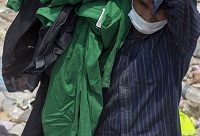
More apparel and footwear companies should join 17 leading apparel brands that have aligned with an important new transparency pledge, a coalition of unions and human rights and labor rights advocates said. The pledge commits companies to publish information that will enable advocates, workers, and consumers to find out where their products are made. The 40-page report, ‘Follow the Thread: The Need for Supply Chain Transparency in the Garment and Footwear Industry,’ came just ahead of the fourth anniversary of the Rana Plaza building collapse disaster in Bangladesh. It calls for companies to adopt the Apparel and Footwear Supply Chain Transparency Pledge. The coalition contacted 72 companies and asked them to adopt and carry out the pledge. The report details their responses and measures their current supply chain transparency practices against the pledge.
A long trail of events
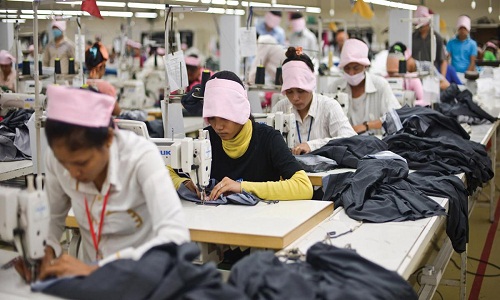
“A basic level of supply chain transparency in the garment industry should be the norm in the 21st century,” said Aruna Kashyap, senior counsel for the women’s rights division at Human Rights Watch. “Openness about a company’s supply chain is better for workers, better for human rights, and shows that companies care about preventing abuse in their supply chains.” The Rana Plaza building collapse on April 24, 2013 killed over 1,100 garment workers and injured more than 2,000. It was preceded by two large factory fires – one in Pakistan’s Ali Enterprises factory and another in Bangladesh’s Tazreen Fashions factory – that killed more than 350 workers and seriously injured many others. Afterwards, labour advocates could not determine which companies’ products were made at these factories and had to hunt for the brand labels from the factory sites and interview surviving workers to determine who was responsible.
By the end of 2016, at least 29 global apparel companies had published some information about the factories that manufacture their products. To build on this momentum, in 2016, a nine-member coalition of labor and human rights organizations and global unions endorsed the Transparency Pledge. Its aim is to create a level playing field in the industry and move it toward a minimum standard for publishing supplier factory information.
The coalition for clean clothes, human rights
The coalition consists of Clean Clothes Campaign, Human Rights Watch, IndustriALL Global Union, the International Corporate Accountability Roundtable, the International Labor Rights Forum, the International Trade Union Confederation, the Maquila Solidarity Network, UNI Global Union, and the Worker Rights Consortium. The Transparency Pledge draws upon existing good practices of global apparel companies and sets a floor, not ceiling, for supply chain transparency. It asks apparel companies to publish important information about supplier factories and their authorized subcontractors. These efforts to publish supplier factory information help assert workers’ human rights, advance ethical business practices and human rights due diligence in apparel supply chains, and build stakeholder trust, in line with the United Nations Guiding Principles on Business and Human Rights.
Many significant investors have begun to urge apparel companies to make their supplier information public. Most recently, the Corporate Human Rights Benchmark, endorsed by 85 investors representing $5.3 trillion in assets, score-carded apparel companies’ supply chain transparency, requiring them to publish at least the names of factories that produced for them.
Transparency is a powerful tool for promoting corporate accountability for garment workers’ rights in global supply chains, the coalition said. It allows workers and labor and human rights advocates to alert the company to rights abuses in its supplier factories. Information about brands’ supplier factories facilitates faster access to grievance redress mechanisms for human rights abuses.
Of the 72 companies that the coalition contacted, 17 will be in full alignment with the pledge standards by December 2017. Many other companies fell short of the pledge standards: five fall just short of the pledge, 18 are moving in the right direction by disclosing at least the names and addresses of cut-make-trim factories, and seven are taking small steps toward publishing supplier factory information – for example, a part of their supplier factories, or at least the names of their supplier factories by country of manufacture, by December 2017. Another 25 apparel companies do not publish information about factories that manufacture their products. Those companies either did not respond or made no commitment to publish any of the information requested.
The coalition urges companies that have not aligned with the pledge to do so by December and to help galvanize the apparel industry toward a basic threshold level of supply chain transparency. “Adhering to a minimum level of supply chain transparency in the pledge is important for accountability efforts,” said Judy Gearhart, executive director at the International Labor Rights Forum. “Companies can do more, but they should at least start with this basic step.”
Adidas has a commitment to create one million pairs of shoes made from up cycled marine plastic in 2017. Using intercepted marine plastic, Adidas is creating high performance products, including swimming and outdoor items.
Among targets are to use more sustainable materials in production, tackling water scarcity and empowerment of supply chain workers, sourcing 100 per cent sustainable cotton by the end of 2018. So far there has been an achievement of 23 per cent water savings per employee on Adidas sites. There has been a growth of 10 per cent in access to the workers' hotline. The service is now available to 2,90,000 workers in 63 strategic supplier factories across Cambodia, Indonesia, Vietnam, and China.
In 2016, for the 17th consecutive time, the company was selected to join the Dow Jones Sustainability Indices, the world’s first global sustainability index family tracking the performance of leading sustainability-driven companies worldwide. The company ranked second in the apparel sector, and fifth in the overall ranking, out of 98 corporations in the newly launched Corporate Human Rights Benchmark.
Adidas is a global leader in the sporting goods industry with the core brands Adidas and Reebok. Based in Germany, the company employs more than 60,000 people across the globe.
Denim Premiere Vision will be held in France from April 26 to 27, 2017. Among the show’s exhibitors are weavers, laundries, manufacturers and accessory makers. Garment manufacturer M&J will disclose a special software through which one can measure and exactly certify how much water is employed when treating and finishing a pair of jeans. Advance Denim will launch a new thermo-regulating and breathable fabric that can be 100 per cent recycled.
The show will offer a new innovation strategy in order to focus more on new projects, on the younger generation and on technology. The event will be closely involved with the market, the industry and brands. The aim is to infuse the sector with a new vitality by creating the denim of tomorrow.
A new interactive space will present Fall/Winter 2018-19 trends offering a mix of physical and digital experiences, climatic performance, thermal activation, luminosity, augmented reality, robotics and connected technologies.
There will be innovative products embedding new technology like a jacket providing the sensation of caress on the wearer’s shoulders, a windbreaker equipped with portable solar panels, garments integrated with sensors, jeans that can guide the wearer with special vibrations. With a new 3-D software jeans can be designed and linked with productive platforms directly.
Earnings and Ebitda margins of Indian textile and apparel exporters will be hit in the near term following the rupee's appreciation against the dollar and weak apparel imports from traditional markets like the US and the UK. Ebitda margins are expected to erode around 150 basis points year-on-year in the fourth quarter ended March 2017.
Ebitda margin -- earnings before interest, tax, depreciation and amortisation divided by total revenue -- is a gauge of a company’s operating profitability. A stronger rupee is likely to have an adverse impact on export volumes and earnings since fresh orders will reduce competitiveness. Realisations are expected to shrink by three to five per cent in the near term and impact profitability of companies across the textile value chain.
The unabated strengthening of the rupee vis a vis the dollar in the current calendar year has increased the challenges of the textile and apparel industry. Export realisations may be dented due to the strong rupee. Over 70 per cent of India’s textile and apparel exports are dollar denominated. Export-oriented apparel manufacturers with unhedged receivable positions will be hurt the most due to their geographically concentrated (US and Europe) earnings profile, low market share and restricted bargaining power with their global clients.



